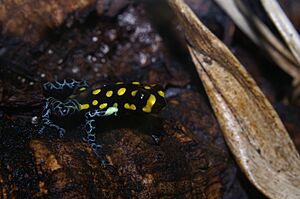Brazilian poison frog facts for kids
Quick facts for kids Brazilian poison frog |
|
|---|---|
 |
|
| Conservation status | |
| Scientific classification | |
| Synonyms | |
|
Dendrobates vanzolinii Myers, 1982 |
The Brazilian poison frog, also called the spotted poison frog, is a small, colorful frog. Its scientific name is Ranitomeya vanzolinii. This frog belongs to the Ranitomeya group, which is part of the Dendrobatidae family. These frogs are often called "poison dart frogs." You can find them living in the Amazon rainforests of Brazil and Peru. They might also live in Bolivia.
Contents
About the Brazilian Poison Frog
What's in a Name?
The frog's scientific name, vanzolinii, is a tribute. It honors Paulo Vanzolini. He was a famous Brazilian scientist. Paulo studied reptiles and amphibians, like frogs. He was also a talented composer.
Appearance and Diet
When fully grown, the Brazilian poison frog is quite small. It measures about 1.6 to 1.9 centimeters long. That's less than an inch! Like other poison dart frogs, this species eats tiny bugs. Its diet includes ants, termites, and small beetles.
Many of these tiny insects naturally contain special chemicals. The frogs eat these bugs and store the chemicals in their skin. This makes their skin toxic. It's a way for them to protect themselves. This defense gets stronger as the frog grows. That's why they are known as "poison frogs."
Family Life
During the time when frogs lay eggs, male frogs make a special sound. It's a trilling call, like a cricket. This sound helps them attract female frogs. Unlike some other poison dart frogs, Ranitomeya vanzolinii parents are very caring. They actively protect and feed their babies.
The female frog lays her eggs in a tiny pool of rainwater. These pools are often found inside bromeliad plants. Bromeliads are plants that can hold water in their leaves. Once the eggs hatch into tadpoles, the parents work together. The male encourages the female to lay an unfertilized egg. This extra egg becomes food for the young tadpoles. The tadpoles eat it until they grow legs and can find their own food. The mother and father frog stay together as a pair during this time.
Where They Live and How They Are Protected
Their Home
These frogs live in special places. Their natural habitats are rainforests. They prefer areas where clouds often cover the mountains. Adult frogs mostly live in trees. You can usually find them up to 2 meters (about 6.5 feet) above the ground. Sometimes they climb even higher!
Protecting the Species
Sadly, the number of these frogs has likely gone down. They face a few threats. One big problem is habitat loss. Their rainforest homes are being destroyed. Another threat is the illegal pet trade. People sometimes try to catch these frogs to sell them as pets. Protecting their homes is important to help these unique frogs survive.


